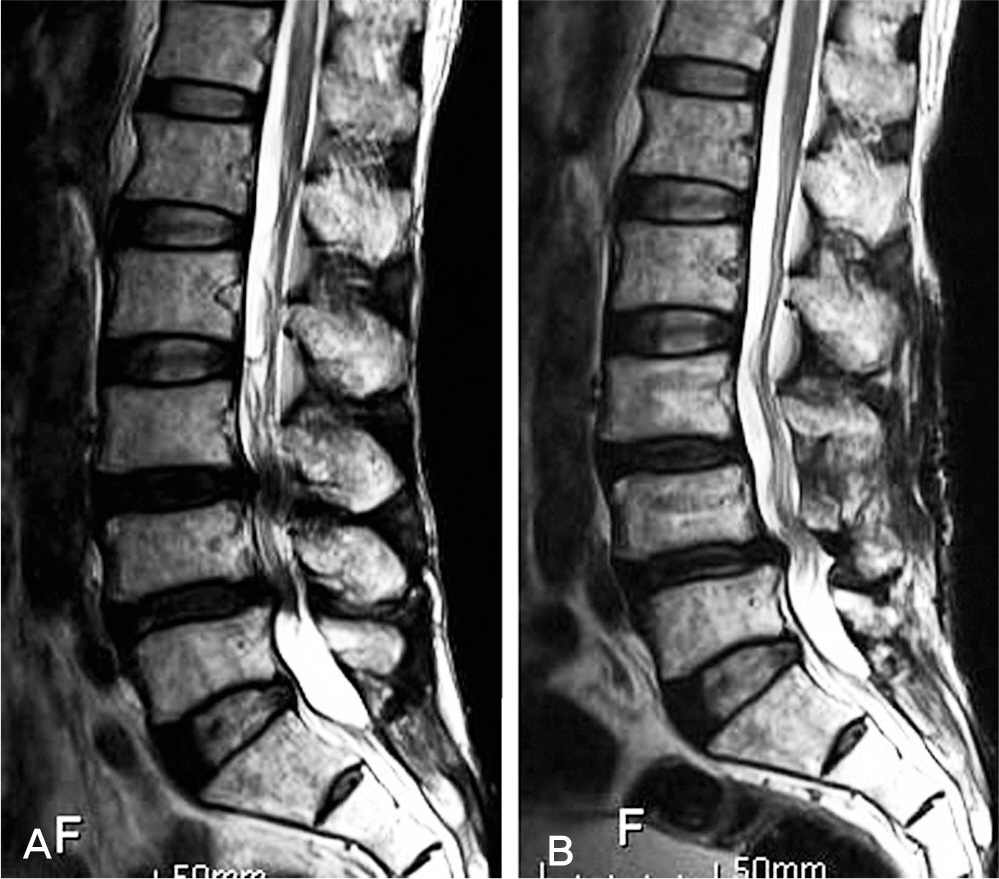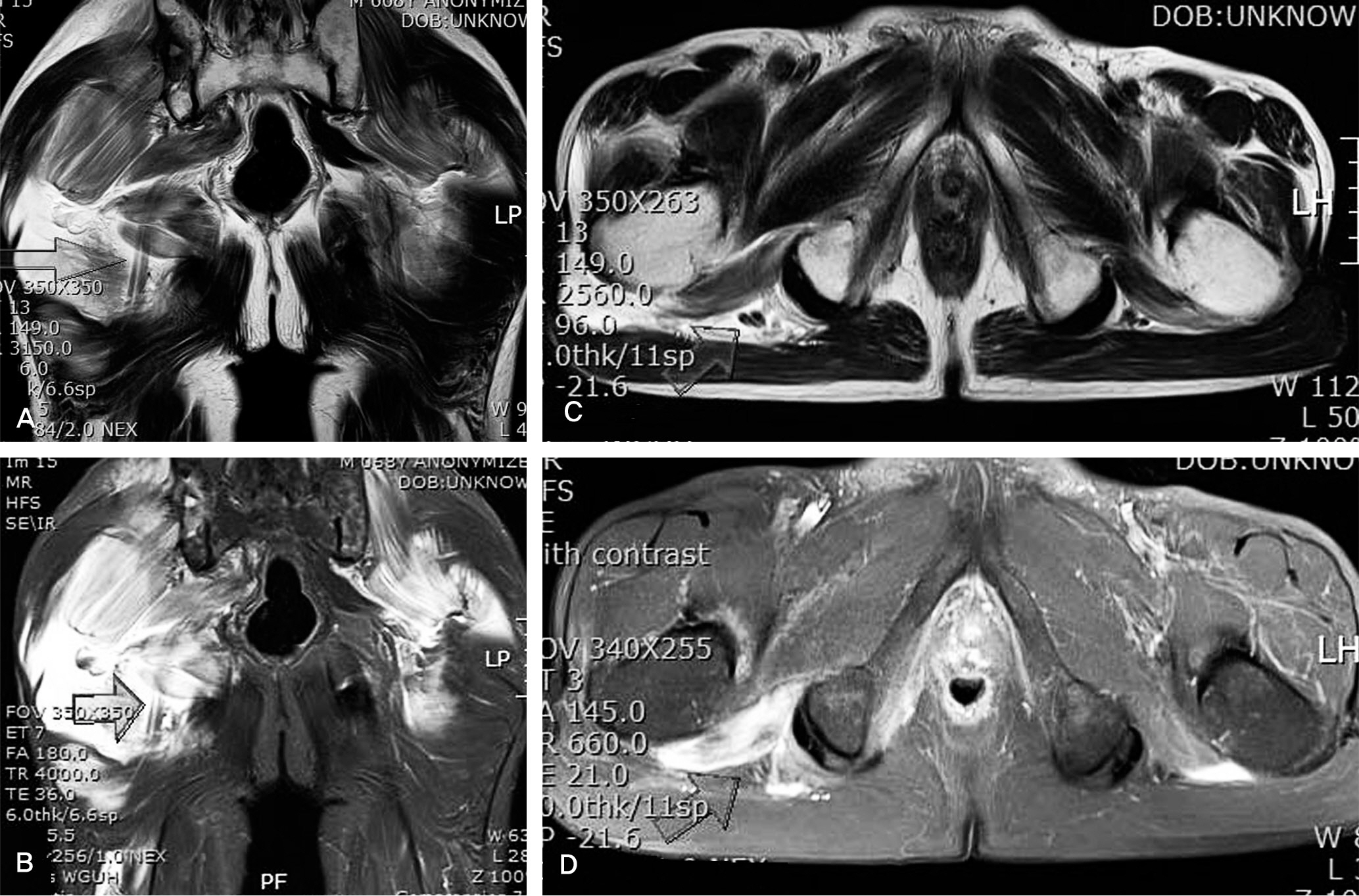J Korean Soc Spine Surg.
2011 Dec;18(4):259-262. 10.4184/jkss.2011.18.4.259.
Acute Sciatic Nerve Palsy after Sleeping in a Sitting Position: Case Report
- Affiliations
-
- 1Department of Orthopedic Surgery, Wonkwang University Sanbon Hospital, Gunpo, Korea. niceo@daum.net
- 2Institue of Wonkwang Medical Science, Iksan, Korea.
- KMID: 1448005
- DOI: http://doi.org/10.4184/jkss.2011.18.4.259
Abstract
- STUDY DESIGN: A case report.
OBJECTIVE
We wanted to present the clinical manifestation and imaging findings of a rare case of acute sciatic nerve palsy with a foot drop similar to lumbar disc herniation developed after sleeping for 8 hours in a sitting position in inebriated condition. SUMMARY OF LITERATURE REVIEW: Sciatic nerve palsy as a complication from being operated in a sitting position have been reported, but here have not been any reported cases of after-sleep sciatic nerve palsy. STUDY SUBJECT AND METHODS: Sixty eight year old male admitted to hospital due to acute onset of right foot drop, subsequent walking difficulty, and numbness of the right calf and foot. Symptoms began after 8 hours of sleeping in a sitting position. Pelvic MRI exam revealed sciatic neuropathy, and also electrophysiological exam revealed sciatic nerve palsy.
RESULTS
The subject patient's conditions started improving after 6 weeks and he was able to walk again on his own.
CONCLUSION
Sciatic nerve injury by prolonged pressure around the buttocks or posterior thighs, albeit rare, can develop and may cause foot drop, parethesia and sciatica.
Figure
Reference
-
1. Baima J, Krivickas L. Evaluation and treatment of peroneal neuropathy. Curr Rev Musculoskelet Med. 2008; 1:147–53.
Article2. Benson ER, Schutzer SF. Posttraumatic piriformis syndrome: diagnosis and results of operative treatment. J Bone Joint Surg Am. 1999; 81:941–9.3. El-Rubaidi OA, Horcajadas-Almansa A, Rodriguez-Rubio D, Galicia-Bulnes JM. Sciatic nerve compression as a complication of the sitting position. Neurocirugia. 2003; 14:426–30.4. Gozal Y, Pomeranz S. Sciatic nerve palsy as a complication after acoustic neurinoma resection in the sitting position. J Neurosurg Anesthesiol. 1994; 6:40–2.
Article5. Henson JT, Roberts CS, Giannoudis PV. Gluteal compartment syndrome. Acta Orthop Belg. 2009; 75:147–52.6. Manigoda M, Dujmovic-Basuroski I, Trikic R, Drulovic J. Acute sciatic neuropathy “post-Saturday palsy”. Srp Arh Celok Lek. 2005; 133:58–61.7. Tacconi P, Manca D, Tamburini G, Cannas A, Giagheddu M. Bed footboard peroneal and tibial neuropathy. A furtherunusual type of Saturday night palsy. J Peripher Nerv Syst. 2004; 9:54–6.
- Full Text Links
- Actions
-
Cited
- CITED
-
- Close
- Share
- Similar articles
-
- Combined Femoral and Sciatic Nerve Palsy Associated with Acetabular Fracture and Dislocation: A Case Report
- Sciatic Nerve Palsy Complicating Gluteal Compartment Syndrome due to Rhabdomyolysis: A Case Report
- Sciatic neuropathy following robot-assisted laparoscopic myomectomy under lithotomy position: A case report
- Sciatic Nerve Palsy Due to Hematoma Following Anticoagulation Therapy for Prevention of Venous Thromboembolism after Total Hip Arthroplasty - A Case Report -
- Delayed Sciatic Nerve Palsy due to Hematoma Related with Anticoagulants Prophylaxis in the Femur Intramedullary Nailing: A Case Report



